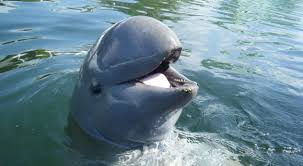
After a 10km cycle ride in the blistering Laos heat, we finally arrived, dripping with sweat, at the vast expanse of the Mekong river. Stretching out to the horizon and scattered with small bushy islands as far as the eye can see, one can easily comprehend why this stretch of the river has been dubbed “The 4000 Islands.” Me and my two travelling companions are here to see the elusive Irradaway dolphin, one of the top attractions here in Don Kong. We all clamber into a slightly sketchy looking boat and are off on our way. It’s not long before we spot 3 dolphins, their curved, finned backs rising gracefully out of the water. Sadly, the encounter is extremely short lived.; they dive down and swim away from us, eventually resurfacing across the invisible boarder into Cambodian waters. “We no follow,” the driver informs us, shaking his head, “they in Cambodia now.” On our return to the mainland, our luck takes a turn for the worse. The noisy engine begins to splutter and fail, leaving us at the mercy of the river current, and for quite some time we drift hopelessly in the wrong direction. To make matters worse, distant forks of lighting spark downwards from the black sky, followed by mighty cracks of thunder. A storm is coming. Fat drops of rain begin pelting us from above as the wind picks up rapidly. The man driving the boat gives a little whimper (never a good sign) as he tries desperately to restart the engine. “We must stop here, too dangerous!” He tells us, as we collide onto one of the many islands. Stranded, shivering and slightly concerned, we wait for what seems like hours in the middle of the tropical storm.
Eventually we make it back to the mainland wondering if the trip was really worth it. But this is Laos; things rarely go exactly as planned, so I am grateful we got to see the dolphins at all. After all, there are only 5 Irradaway dolphins left in the country, meaning that we saw 60% of the entire Laos population. This fact is surprising, given the cultural and spiritual significance of the dolphins to Laos and Cambodian people. In fact, Irradaway Dolphins are pretty much the only animals exempt from ending up on a dinner plate here. According to local folklore, the creatures are sacred; human souls in dolphin skin. The story tells of a beautiful maiden with the body of a fish who was forced to marry a magical Python. Distraught and desperate to avoid her fate, she decided to cast herself into the Mekong river, but her attempt at suicide failed and she was transformed into a dolphin. The Dolphins’ significance to local communities goes far beyond the mythology, for they also provide an important source of income for communities involved in dolphin-watching ecotourism. Furthermore, their protection is crucial to the overall health of the Mekong river.
So the question begs, why are their numbers dwindling so drastically, and what can be done to save them? As with much aquatic life, the main threat to the dolphins are fishing nets. Bycatch and accidental capture in fishing gear is the primary cause of their endangered status. The World Wildlife Fund is working with locals to reduce Bycatch in a number of ways. They teach local communities the importance of conservation, develop community fishery management zones, and reduce fishing pressure by supporting alternative livelihood development. It is yet to be seen if these threat reduction strategies will be successful in preserving the local population, but the WWF remains optimistic, and their work continues to this day. (If you would like to support their efforts you can donate to the WWF:WWF.panda.org)
All this talk of wildlife loss and endangered species has gotten me thinking about the global implications. If we cannot save such an enigmatic creature as the Irradaway dolphin, what hope do we have for lesser known endangered creatures that are also crucial to ecosystems? What will become of the ugly Kakapo fish? What is the fate of the lesser known Leaping Lesbian Lizards? Some 110,000 species are now listed as critically endangered, but we only really hear about the most iconic and majestic creatures; the tigers, the pandas, the dolphins. Even I am guilty of this; I am yet to write a blog post about an obscure species in need of saving. I suppose charities select the most charismatic animals in the hope of leveraging their inherent cuteness to create broader conservation awareness. This seems like a logical strategy, rather than providing an eclectic sampling of species to show the vast diversity of animals at risk. However, there has been much debate over whether this is the best tactic to use in conservation efforts. Chris Packham caused much controversy over his statement claiming that pandas should be left to face extinction. Writing for the Guardian, he argues that “conservation, both nationally and globally, has a limited amount of resources, and I think we’re going to have to make some hard, pragmatic choices… of course, it’s easier to raise money for something fluffy… But we have to accept that some species are stronger than others.”
Many environmentalists argue that we must focus on the more iconic animals in order to get people’s attention and raise awareness. But I can’t help seeing where Packham is coming from. Limited resources must surely go to the animals with the highest chance of survival, and their worth should be measured by their importance to the ecosystem, rather than their capacity to pull at people’s heart strings. The Irrawaddy dolphin, however, manages to combine both qualities. They are a not only a symbol of the magnificent if the Mekong river, but are also crucial to the general health of the entire ecosystem. I feel honoured to have been able to see them in the wild and would encourage people to support efforts to conserve them.
